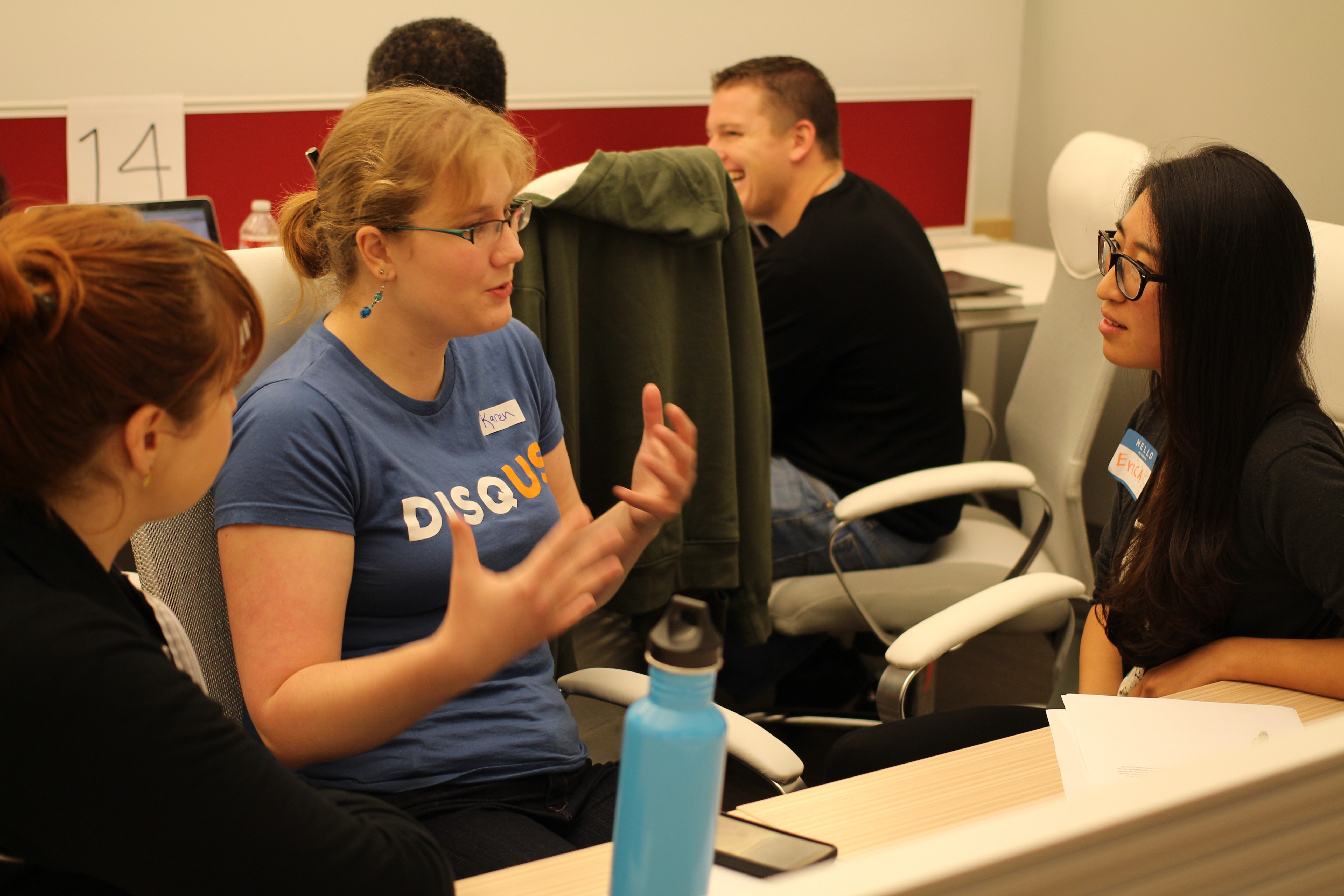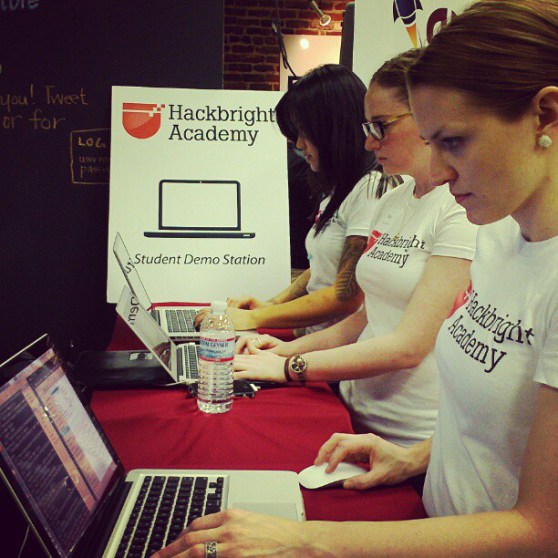Andrée Brazeau was a project manager with a degree in mechanical engineering. Eighteen months ago, she moved to San Francisco and started looking for work. A year into her job search, she had heard the same response time and time again: “We’re looking for someone with programming experience.”
So Brazeau learned how to code.
As the old women-in-tech debate fades out of the current hype cycle, a related trend is starting to gain momentum. In the the learn-to-code craze, online schools like Codecademy and in-person courses like Dev Bootcamp are springing up to meet a huge need for more developers across a wide range of industries.
Speaking volumes about both trends, Hackbright Academy is a women-only school in San Francisco that teaches its students everything they need to know to become entry-level programmers and get job offers right away — and does so in 10 weeks.
By putting her life and career on hold and signing up for a $7,500, full-time crash course, each student hopes to change her life, to jump from a salary of $30,000 or $40,000 to something that can sustain one person or even a family in an expensive city like San Francisco. But while this option is a quick fix for tech’s gender imbalance, some worry it’s not enough to fix the industry’s brogramming culture.
Girlschool

“For any person who wants to learn programming by themselves, San Francisco is the best place,” Brazeau said in an email to VentureBeat. “There are so many people in software here that it was easy for me to find group to help me learn.”
She started out with the usual suspects of online tutelage: W3Schools and Learn Python the Hard Way. Between these tools and a couple in-person groups, she was able to put together her first website.
“But you know, there is a big difference between building a static website and a web application,” she said. When she heard about the Hackbright program, she said, “I knew right away this was exactly what I needed.”
Ashley Lorden also had experimented with various online tools to learn to code. A nonprofit employee with an econ degree from Brown, Lorden was technically inclined and ended up doing web-related work wherever she went.
But to make the jump into a career as a software developer, Lorden said she only saw two options: returning to university for a computer science degree or doing nonprofit work at a tech company where she could eventually transition into a technical role. Neither route seemed particularly expeditious.
“I didn’t think it was possible to become a developer in a reasonable timeline until I found out about Hackbright,” said Lorden.
The most interesting part of Hackbright’s program is its gender split: 100 percent women students.
“I have always been surrounded by men,” Brazeau said, “at university in mechanical engineering and in my past jobs.” In spite of the radical change, Brazeau said she easily made friends and overcame her fears. In the end, she said, “I was not uncomfortable. I guess Christian and David were lot more uncomfortable than we were.”
By men, for women

“Christian and David” are Christian Fernandez and David Phillips, Hackbright’s cofounders. Fernandez is the veteran coder of the two; he’s worked at places like Fuzebox and Ask.com and has done a bit of developer instruction as well. In fact, Fernandez taught at the first-ever Dev Bootcamp.
Philips had been making apps with Fernandez for about a year, with Fernandez teaching him how to code, when the pair got the idea to offer a coding class. Eighteen guys and just three women showed up. As much as they wanted a 50/50 split between the genders, they realized it was unrealistic.
So why not offer a class only for women?
While that idea has been posited by many women’s groups in recent times, it seemed more audacious coming from a couple dudes. “That was the biggest risk,” said Phillips in an interview with VentureBeat. “We’re two guys. We expected to be judged; it was kinda scary.”
Fernandez and Phillips started meeting with developer women’s organizations, “getting to know everybody and letting them know what our intentions were.” The duo was pleasantly surprised. “We really got a positive response from everybody,” Phillips said.
And with that, Hackbright was a go.
Entering entry level

Phillips said Hackbright students “range from liberal arts to women’s studies to mechanical and electrical engineering. The one thing they all have in common is they’ve all been trying to learn how to code on their own.”
Hackbright takes that motivation and turns it toward new career opportunities. “We’ve had students come in with zero programming experience,” said Philips, “and 88 percent of our last graduating class had job offers.”
Brazeau is one of the 88 percent. Today, she works as a software engineer for Avos. “Before the class, I thought I could never get a job in software,” she said.
The Hackbright instructors prepared the students for technical interviews, set up a career-day event, and encouraged students to be confident about their prospects. “For four weeks, I had almost one interview a day,” said Brazeau.
Lorden also got a full-time job offer as a SurveyMonkey engineer. SurveyMonkey was so pleased with Lorden’s work that it made job offers to two Hackbright grads from the current class and is sending a current finance employee to the next session, who will return from the training to work on the engineering team.
In a dev-hungry environment such as this, many companies are willing to reimburse the $7,500 tuition to get a good, trainable, motivated engineer, Phillips said, even when that engineer is as entry-level as it gets.
“You think to yourself, ‘What crazy person would pay me to do something I just started learning, given that I’ll spend most of my time asking them questions and Googling for solutions?'” Lorden said. “But I came to realize that being a developer is largely about learning and trying and thinking, not about coming in with the answers ready.”
And although good developers are in short supply, companies are desperate to create diversity. A welcome tidbit of common startup wisdom is that diverse teams — ethnically diverse, gender-diverse, every kind of diverse — build better products.
Selina Tobaccowala is SurveyMonkey’s engineering SVP. As one of the company’s hiring decision-makers, she said that gender diversity has been hugely important all along in building out the engineering team.
“It helps in problem solving, in critical thinking — in a lot of different ways. For me, it really enhances the product. Women have a unique perspective based on their experiences, and that’s been instrumental for us.”
Death to brogramming

“The part of my Hackbright experience that most surprised me was how important my peer group of awesome women was,” said Lorden. “We seriously bonded going through this career transition together.”
San Francisco’s army of hackers is predominantly male — that’s no secret. But the Bay Area is also home to a relatively large population of female devs, if only by virtue of the sheer number of developers it contains.
“What we’ve learned from doing this is that the community is really strong. Everyone’s really supportive of each other, and our alumni stay in touch and help each other get jobs,” said Phillips.
Of course, the insular safety of an all-women environment can’t logically be sustained in the real, working world.
“For the most part, obviously they miss the cameraderie, but they’re doing great,” said Philips of Hackbright grads in the working world. “The other engineers seem to be warm and accepting.”
Of course, there’s always the exception to that rule. “When I went to a JavaScript meetup of 40 and was the only woman, other than the receptionist,” said Lorden, “I felt like people were staring at me.”
Phillips pointed out that technology, as a historically male-dominated industry, tends to have a male-dominated culture. To get more women in tech in the first place, part of the solution is senior-level women engineers who are willing to hire them.
“It’s a chicken-egg problem,” he said. “You need more women on your team in leadership positions to hire more women.”
And until you have women as engineering team leaders, he said, you have an environment where bias and discrimination can take root. Not obviously, but insidiously.
“I think [brogramming culture] is kind of obnoxious,” Phillips said. “Before, you had male-dominated teams, and there is the subculture there, and it kind of goes — not unnoticed, but people don’t do anything about it. They don’t try to stop it. But when there are women on the team, you realize that locker-room stuff isn’t acceptable. And people are starting to realize that it’s not welcoming and not good to grow their team. It’s going to become less of an issue as more women get into technology.”
Women in tech

The women-in-tech topic as a whole has been debated ad nauseum. But even though we’re tired of the topic, the numbers aren’t changing. Currently fewer women — a lot fewer women — are graduating from computer science programs and/or participating in the industry in a technically meaningful way than there were in the 1980s, when “women’s lib” was still a term people used to describe the out-there idea that people of different genders are professionally and intellectually equal.
So while we wait to tackle the root of the gendered-tech problem (education of girls beginning before they enter school), decades are passing and tech is becoming more gender biased, not less. In a sense, Hackbright and its ilk are letting motivated, smart women cut the line, perhaps helping to take a few years off the depressingly long curve of qualified women engineers over time.
But the quick fix isn’t the ultimate solution. As Fernandez himself pointed out in a recent blog post, the learn-to-code movement is meeting a very immediate need and fixing a sudden engineer shortage, but it’s not creating a stable, nurturing culture of thoughtful, experienced programmers.
“First we start with Codecademy’s Code Year,” he wrote, referencing that startup’s 12-month email-driven programming course. “Next, Hungry Academy [another coding crash course] takes five months and feeds you into LivingSocial’s engineering team. Bloc.io [a coding boot camp] schedules 12 weeks. Starter League [formery Code Academy, thank god one of them changed their name] takes 11 weeks in Chicago. Dev Bootcamp in S.F. took 10 weeks but has switched to nine. App Academy also takes nine, and now codeStreak takes six.
“It’s some sort of bizarre race to the bottom. If we extrapolate here, we should expect to soon see a school that promises to make you forget how to program in a single week.”
While everyone involved acknowledges Hackbright for what it is — a jumpstart, a quick fix — most would agree that when it comes to gender in particular, the crash-course mentality is not the biggest problem our industry has.
“The positive thing is, they’re taking very accomplished women who’ve gone to good universities and have studied other topics — biotech, finance — and given them an intensive course,” said Tobaccowala. “Obviously, it’s not the same education as a four-year university where you’re getting more breadth. But they’re able to be really productive in the workplace from day one. … These women are super-motivated and willing to learn on the job and take more training.”
Better still, the jump-start can get the best women in the program from entry-level positions to management or executive positions — meaning more women who can hire more women.
“For us, it’s about performance and leadership capabilities, communication skills,” said Tobaccowala. “I see no reason why two, three, four years later, they couldn’t manage an engineering team.”
But while Hackbright and the rest are doing truly good work, getting women into the pipeline at the entry-level stage where they can and will continue to hone their talents, it’s not enough. If women developers are ever to be an unquestioned norm of the technology workforce, we have to keep plugging away at our earliest education of young girls — and even more importantly, at our own secret biases, fears, and expectations.
Hackbright Academy’s spring class begins March 4; the application deadline is Tuesday.
Image credits: AISPIX by Image Source/Shutterstock, Maria Sbytova/Shutterstock, lev dolgachov/Shutterstock; non-stock images via Hackbright
VentureBeat's mission is to be a digital town square for technical decision-makers to gain knowledge about transformative enterprise technology and transact. Learn More

